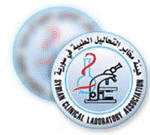| المجلد 6 ,
العدد 9
, جمادى الأولى 1434 - نيسان(أبريل) 2013 |
| |
| عداوى الجراثيم الهوائية المرافقة للحروق في المستشفيات الحكومية السورية |
| Aerobic Bacterial Infections Associated with Burns
in the Syrian Government Hospitals
|
| د. حمود الكدرو*، أ. د. فايز الدغلاوي**، وأ. د. مصطفى العموري* |
| AL-Kadrou H; AL-Dghlawi F.and AL-Ammouri M. |
*كلية الصيدلة، **كلية الطب، جامعة دمشق.
*Faculty of Pharmacy, **Faculty of Medicine, Damascus University.
|
| الملخص Abstract |
| بسبب انتشار العداوى لدى مرضى الحروق المقيمين في المستشفيات والدور الهام لهذه العداوى في التسبب بوفاة المرضى عن طريق جراثيم هوائية ذات مقاومة مرتفعة للمضادات الحيوية، لذلك هدفنا في دراستنا إلى عزل واستعراف الجراثيم الهوائية المسببة لعداوى مرضى الحروق في المستشفيات ودراسة حساسيتها للمضادات الجرثومية وفقا للطرق المعيارية، حيث قمنا بعزل 109 ذرية جرثومية من 53 عينة. وكانت نسبة الجراثيم سلبية الغرام 53% وإيجابية الغرام 47%، بما فيها العنقوديات الذهبية بنسبة 33.5% والزائفة الزنجارية 18.43% و الكلِبْسيلَّةُ الرِّئَوِيَّة 17.43% وكل من الإشريكية القولونية والعنقوديات البشروية 13.76% والمُتَقَلِّبَةُ الرَّائِعَة 2.75%. وكانت الجراثيم إيجابية الغرام جميعها حساسة تماماً على التيغيسكلين Tigicyclin وبدرجة أقل على الدوكسيسكلين Doxycycline والأوفلوكساسين Ofloxacin والأوغمنتينين Augmentin، في حين أن الجراثيم سلبية الغرام كانت حساسة بشكل كبير على البولي مكسينات Polymexines والتيغيسكلين Tigicyclin والفلوروكينولون Fluoroquinolone والأميكاسين Amikacin ، وأظهر البوفيدون اليودي 4% كمادة مطهرة كفاءة عالية على الأنواع الجرثومية ذات المقاومة المرتفعة على المضادات الحيوية، في حين كانت كفاءة البنزالكونيوم كلورايد 0.05% ضعيفة على معظم الجراثيم، ولم يكن لحمض الأسيتيك 1.25% كفاءة وفق المعايير الفرنسية. |
Because of the prevalence of infections with burns patients in hospitals and the significant role of these infections in causing death of patients by aerobic bacteria which has high resistance to antibiotics, so in our study we aimed to isolate and identify the aerobic bacteria that causing infections of burn patients in hospitals and the study their sensitivity of anti-microbials in accordance with standard methods, we isolated 109 strains from 53 samples. The percentage of Gram-negative bacteria was 53% and Gram-positive was 47% including Staphylococcus aureus 33.5% and Pseudomonas aeruginosa 18.43%, and Klebsiella pneumoniae 17.43%, and both of Escherichia coli and Staphylococcus epidermidis 13.76%, and Proteus mirabilis 2.75%. All Gram-positive bacteria was sensitive completely to Tigicyclin and less to Doxycycline and Ofloxacin and Augmentin, while Gram-negative bacteria was sensitive largely to Polymexines, Tigicyclin, Fluoroquinolone and Amikacin, and povidone iodine 4% as antiseptic showed high efficiency to high resistant bacteria, while benzalkonium chloride 0.05% had little efficiency on most bacteria, and Acetic acid 1.25% did not have efficiency according to the standards of France. |
| |
| |
| |
| |
| |
| |
| |
| |
| |
| |
| |
| |
| |
| |
| المجلد 6 ,
العدد 9
, جمادى الأولى 1434 - نيسان(أبريل) 2013 |
|
|
|
